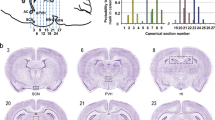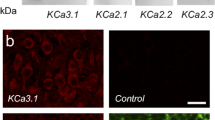Abstract
KATP channels are K+ channels whose activity is inhibited by the presence of and enhanced by the absence of cytosolic ATP. This property allows KATP channels to sense cellular intermediary metabolism and directly couple this information to the modulation of membrane excitability. Indeed, recent studies from our laboratory and others have suggested that activation of KATP channels during anoxia is important in the response and adaptation of central neurons to hypoxia. In order to identify KATP channels from human brain, we performed a polymerase chain reaction (PCR) using human cerebral cortex mRNA and primers derived from the ROMK1 sequence, a cDNA clone encoding an ATP-regulated potassium channel, recently isolated from rat kidney. We thus identified a novel 308-bp PCR product, pKCNJ1, whose expression was found to be restricted to a 3.0-kb band in the kidney by probing a human multiple tissue northern blot. pKCNJ1 was then used to isolate genomic clones and, using fluorescence in situ hybridization (FISH) to human metaphase chromosomes, was mapped to chromosome 11q.
Similar content being viewed by others
References
Ashcroft FM (1988) Adenosine 5′-triphosphate-sensitive potassium channels. Annu Rev Neurosci 11:97–118
Ashford MLJ, Boden PR, Treherne JM (1990) Glucose-induced excitation of hypothalamic neurons is mediated by ATP-sensitive K+ channels. Pflugers Arch 415:479–483
Cook DL, Hales CN (1984) Intracellular ATP directly blocks K+ channels in pancreatic β-cells. Nature 311:271–273
Grissmer S, Ghanshani S, Dethlefs B, McPherson JD, Wasmuth JJ, Gutman GA, Cahalan MD, Chandy KG (1992) The Shaw-related potassium channel gene, Kv3.1, on human chromosome 11, encodes a type 1 K+ channel in T cells. J Biol Chem 267:20971–20979
Haddad GG, Jiang C (1993) O2 deprivation in the central nervous system: on mechanisms of neuronal response, differential sensitivity and injury. Prog Neurobiol 40:277–318
Ho K, Nichols GG, Lederer WJ, Lytton J, Vassilev PM, Kanazirska MV, Hebert SC (1993) Cloning and expression of an inwardly rectifying ATP-regulated potassium channel. Nature 362:31–38
Janssen LAJ, Sandkuyl LA, Merkens EC, Maat-Kievit JA, Sampson JR, Fleury P, Hennekam RCM, Grosveld GC, Lindhout D, Halley DJJ (1990) Genetic heterogeneity in tuberous sclerosis. Genomics 8:237–242
Jiang C, Haddad GG (1991) Effect of anoxia on intracellular and extracellular potassium activity in hypoglossal neurons invitro. J Neurophysiol 66:103–111
Jiang C, Haddad GG (1994) A direct mechanism for sensing low oxygen levels by central neurons. Proc Natl Acad Sci USA 91:7198–7201
Jiang C, Xia Y, Haddad GG (1992) Role of ATP-sensitive K+ channels during anoxia: major differences between rat (newborn, adult) and turtle neurons. J Physiol 448:599–612
Krishnan SN, Frei E, Swain GP, Wyman RJ (1993) Passover: a gene required for synaptic connectivity in the giant fiber system of Drosophila. Cell 73:967–977
Kubo Y, Baldwin TJ, Jan YN, Jan LY (1993) Primary structure and functional expression of a mouse inward rectifier potassium channel. Nature 362:127–133
Lichter P, Tang CC, Call K, Hermanson G, Evans GA, Housman D, Ward DC (1990) High resolution mapping of human chromosome 11 by in situ mapping with cosmid clones. Science 247:64–69
Lipman DJ, Pearson WR (1985) Rapid and sensitive protein similarity searches. Science 227:1435–1441
McConville CM, Formstone CJ, Hernandez D, Thick J, Taylor AMR (1990) Fine mapping of the chromosome 11q22–23 region using PFGE, linkage, and haplotype analysis; localization of the gene for ataxia telangiectasia to a 5cM region flanked by NCAM/DRD2 and STMY/CJ52.75, phi2.22. Nucleic Acids Res 18:4335–4343
McNamara JO, Eubanks JH, McPherson JD, Wasmuth JJ, Evans GA, Heinemann SF (1992) Chromosomal localization of human glutamate receptor genes. J Neurosci 12:2555–2562
Noma A (1983) ATP-regulated K+ channels in cardiac muscle. Nature 305:147–148
Ried T, Rudy B, Vega-Saenz de Miera E, Lau D, Ward DC, Sen K. (1993) Localization of a highly conserved human potassium channel gene (NGK2-KV4; KCNC1) to chromosome 11p15. Genomics 15:405–411
Searle AG (1990) Comparitive genetics of albinism. Ophthalmic Paediatr Genet 11:159–164
Spruce AE, Standen NB, Stanfield PR (1985) Voltage-dependent, ATP-sensitive potassium channels of skeletal muscle membrane. Nature 316:734–738
Standen N, Quayle JM, Davis NW, Brayden JE, Huang Y, Nelson MT (1989) Hyperpolarizing vasodilators activate ATP-sensitive K+ channels in arterial smooth muscle. Science 345:77–180
Takano M, Noma A (1993) The ATP-sensitive K+ channel. Prog Neurobiol 41:21–30
Wang WH, White S, Geibel J, Giebisch G (1990) A potassium channel in the apical membrane of rabbit thick ascending limb of Henle's loop. Am J Physiol 258:F244–53
Author information
Authors and Affiliations
Rights and permissions
About this article
Cite this article
Krishnan, S.N., Desai, T., Ward, D.C. et al. Isolation and chromosomal localization of a human ATP-regulated potassium channel. Hum Genet 96, 155–160 (1995). https://doi.org/10.1007/BF00207372
Received:
Revised:
Issue Date:
DOI: https://doi.org/10.1007/BF00207372




